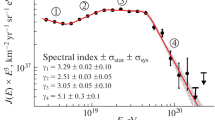Abstract
The Auger Project studies the highest energies known in nature with an emphasis on energies ≥5 × 1019 eV, which are cosmic rays coming from the outer space reaching the Earth's surface with a very low flux. The questions to be elucidated are what are the origin, energy, production mechanism, and chemical composition of these cosmic rays. Auger aims at building two observatories in both the hemispheres and in 2000 the construction of the austral observatory started. Auger's two distinctive features are its exceptional size and its hybrid nature. It spans over an area of 3000 km2 and is constituted by 24 fluorescence detector telescopes and 1600 surface detectors. As such, it will provide a large number of events with less systematic detection uncertainties.
The construction of the Southern Observatory in Argentina is quite advanced and the buildings at the Central Station in Malargüe city are already operational. So are the telescope buildings at Cerros Los Leones and Coihueco (two prototype telescopes were operational at Los Leones, which have now been dismantled), 32 surface detectors, and the telecommunication and data acquisition systems. About 20-hybrid events/months were detected and currently two events/hours are registered with the surface detector array. The detection of hybrid events is the most important issue since it shows that the equipment operates within the design parameters.
Similar content being viewed by others
References
Greisen, K.: 1996, Phys Rev Lett 16, 748; Zatsepin, G. and Kuzmin, V.: 1966, JETP Lett. 4, 78.
Takeda, M., Sakaki, N., Honda, K., Chikawa, M., Fukushima, M., Hayashida, N., Inoue, N., Kadota, K., Kakimoto, F., Kamata, K., Kawaguchi, S., Kawakami, S., Kawasaki, Y., Kawasumi, N., Mahrous, A.M., Mase, K., Mizobuchi, S., Morizane, Y., Nagano, M., Ohoka, H., Osone, S., Sasaki, M., Sasano, M., Shimuzi, H.M., Shinozaki, K., Teshima, M., Torii, R., Tsushima, I., Uchihori, Y., Yamamoto, T., Yoshida, S., and Yoshii, H.: for the AGASA Collaboration, Astro-ph/ 0209422 v3, 2002, and accepted Astroparticle Phys.
Abu-Zayyad, T., Archbold, G.C., Bellido, J.A., Belov, K., Belz, J.W., Bergman, R., Boyer, J., Cao, Z., Clay, R.W., Dawson, B.R., Everett, A.A., Girard, J.H.V., Gray, R.C., Hanlon, W.F., Jones, B.F., Jui, C.C.H., Kieda, D.B., Kim, K., Knapp, B., Loh, E.C., Martens, K., Martin, G., Manago, N., Mannel, E.J., Matthews, J.A.J., Matthews, J.N., Meyer, J.R., Moore, S.A., Morrison, P., Moosman, A.N., Mumford, J.R., Munro, M.W., Perera, L., Reil, K., Riehle, R., Roberts, M., Seman, M., Schindel, M.A., Schnetzer, S., Shen, P., Simpson, K.M., Smith, J.D., Sokolsky, P., Song, C., Spinger, R.W., Stokes, B.T., Thomas, S.B., Thomson, G.B., Westerhoff, S., Wiencke, L.R., Vander Veen, T.D., Zech, A., Zhang, X.: for the HiRes Collaboration Astro-ph/0208301 v1, 2002.
The Auger Collaboration: 1996, Pierre Auger Project Design Report (2nd edn.), Revised March 14, 1997.
The Auger Collaboration: Properties and Performance of the Prototype Instrument for the Pierre Auger Observatory. Accepted Nucl. Inst. and Meth.
Bauleo, P., Bonifazi, C.B., Filevich, A., and Reguera, A. for the Pierre Auger Collaboration: 2001, Nucl.Inst.and Meth.A 463, 175–182.
Allison, P.S., Bauleo, P., Bertou, X., and Bonifazi, C.B.: Surface Detector Calibration in the Engineering Array, Auger Technical Note GAP 2002–028.
Chou A.S.: Vertical Equivalent Muon Study with the Fermilab Tank, Auger Technical Note, GAP 2002–08; Slater, W.E., Tripathi, A., and Arisaka, K. Auger Technical Note, GAP 02–063.
Etchegoyen, A. Track Geometry and Smearing of the Bump Calibration, Auger Technical Note, GAP-2002–078.
Cordero, A., Cantoral, E., Castro, J., Fernandez, A. and Pastrana, R.: Proposal for the Optical System of the Fluorescence Detector of the Auger Project, Auger Technical Note, GAP–96–039.
Biral, A.R.P., Medina Tanco, G.A., Reis, H.C., Landulfo, E., Freitas, A.Z., Teixeira, R. and Escobar, C.O.: Proposal of an Additional Atmospheric Monitoring System for the Auger Site, Auger Technical Note GAP-2002–023.
Filipcic, A., Horvat, M., Veberic, D., Zavrtanik, D. and Zavrtanik, M.: 2003, Astropart.Phys. 18, 501–512. Scanning LIDAR Based Atmospheric Monitoring for Fluorescent Detectors of Cosmic Showers, Mostaf´ a, M.: LIDAR Data An´ alisis Using the Multi-Angle Method.Effects on Shower Profile Reconstruction, Auger Technical Note GAP-2002–068.
Ave, M., Knapp, J., Marchesini, M., Roth, M., and Watson, A.A.: A Preliminary Analysis of the 11-fold Event 184599, Auger Technical Note GAP-2002–020.
Matthiae, G. for the Pierre Auger Collaboration, The Auger Observatory for High Energy Cosmic Rays, Proceeding of ICHEP-2002.
Pierre Auger Observatory Technical Design Review.Available at www.auger.org/admin <http://www.auger.org/admin>.
Author information
Authors and Affiliations
Corresponding author
Rights and permissions
About this article
Cite this article
Etchegoyen, A. The Auger Observatory in Argentina. Astrophysics and Space Science 290, 379–387 (2004). https://doi.org/10.1023/B:ASTR.0000032536.35456.82
Issue Date:
DOI: https://doi.org/10.1023/B:ASTR.0000032536.35456.82




